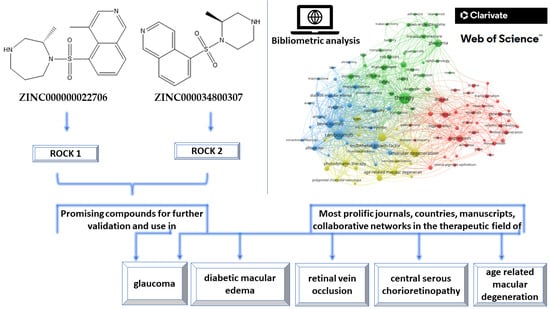Exploring New Therapeutic Avenues for Ophthalmic Disorders: Glaucoma-Related Molecular Docking Evaluation and Bibliometric Analysis for Improved Management of Ocular Diseases
Abstract
:1. Introduction
2. Materials and Methods
2.1. Ligand Preparation
2.2. Protein Preparation
2.3. Molecular Coupling Assessments
2.4. In Silico Screening
2.5. Estimates of Pharmacokinetic Data
3. Results
3.1. Molecular Docking of Compounds against ROCK1
3.2. Molecular Docking of Compounds against ROCK2
3.3. In Silico Screening of the Candidate with the Most Potential
3.4. Computational Assessments of Relevant Pharmacokinetic Data for Newly Found Molecules
4. Bibliometric Analysis
4.1. Period 2011–2023
4.1.1. Assessment of the Most Prolific Nations
4.1.2. Evaluation of the Most Productive Journals
4.1.3. Assessment of the Most Prolific Authors
4.1.4. Citation Analysis
4.1.5. The Topic’s Most Involved Organizations
4.2. Science Mapping
4.2.1. Networks of Collaboration between Nations
4.2.2. Resource Average Publication Year and Citation System Diagram
4.2.3. Keyword System Mapping and Terms Co-Occurrence System Diagram
4.3. Discussions
5. Limitations
5.1. Molecular Docking Approach
5.2. Bibliometric Analysis
6. Conclusions
Author Contributions
Funding
Institutional Review Board Statement
Informed Consent Statement
Data Availability Statement
Acknowledgments
Conflicts of Interest
References
- Landau, K.; Kurz-Levin, M. Retinal Disorders. In Neuro-Ophthalmology; Kennard, C., Leigh, R.J.r., Eds.; Elsevier: Amsterdam, The Netherlands, 2011; Volume 102, pp. 97–116. ISBN 0072-9752. [Google Scholar]
- Bungau, S.; Abdel-Daim, M.M.; Tit, D.M.; Ghanem, E.; Sato, S.; Maruyama-Inoue, M.; Yamane, S.; Kadonosono, K. Health Benefits of Polyphenols and Carotenoids in Age-Related Eye Diseases. Oxid. Med. Cell Longev. 2019, 2019, 9783429. [Google Scholar] [CrossRef] [PubMed]
- Bodea, F.; Bungau, S.G.; Bogdan, M.A.; Vesa, C.M.; Radu, A.; Tarce, A.G.; Purza, A.L.; Tit, D.M.; Bustea, C.; Radu, A.-F. Micropulse Laser Therapy as an Integral Part of Eye Disease Management. Medicina 2023, 59, 1388. [Google Scholar] [CrossRef]
- Wong, W.L.; Su, X.; Li, X.; Cheung, C.M.G.; Klein, R.; Cheng, C.-Y.; Wong, T.Y. Global Prevalence of Age-Related Macular Degeneration and Disease Burden Projection for 2020 and 2040: A Systematic Review and Meta-Analysis. Lancet. Glob. Health 2014, 2, e106-16. [Google Scholar] [CrossRef] [PubMed]
- Campochiaro, P.A. Retinal and Choroidal Vascular Diseases: Past, Present, and Future: The 2021 Proctor Lecture. Investig. Ophthalmol. Vis. Sci. 2021, 62, 26. [Google Scholar] [CrossRef]
- Liew, G.; Quin, G.; Gillies, M.; Fraser-Bell, S. Central Serous Chorioretinopathy: A Review of Epidemiology and Pathophysiology. Clin. Exp. Ophthalmol. 2013, 41, 201–214. [Google Scholar] [CrossRef]
- Allison, K.; Patel, D.; Alabi, O. Epidemiology of Glaucoma: The Past, Present, and Predictions for the Future. Cureus 2020, 12, e11686. [Google Scholar] [CrossRef]
- Hanumunthadu, D.; Tan, A.C.S.; Singh, S.R.; Sahu, N.K.; Chhablani, J. Management of Chronic Central Serous Chorioretinopathy. Indian J. Ophthalmol. 2018, 66, 1704–1714. [Google Scholar]
- Brand, C.S. Management of Retinal Vascular Diseases: A Patient-Centric Approach. Eye 2012, 26, S1–S16. [Google Scholar] [CrossRef]
- Weinreb, R.N.; Aung, T.; Medeiros, F.A. The Pathophysiology and Treatment of Glaucoma: A Review. JAMA 2014, 311, 1901–1911. [Google Scholar] [CrossRef]
- Schuster, A.K.; Erb, C.; Hoffmann, E.M.; Dietlein, T.; Pfeiffer, N. The Diagnosis and Treatment of Glaucoma. Dtsch. Arztebl. Int. 2020, 117, 225–234. [Google Scholar] [CrossRef]
- Hutnik, C.; Crichton, A.; Ford, B.; Nicolela, M.; Shuba, L.; Birt, C.; Sogbesan, E.; Damji, K.F.; Dorey, M.; Saheb, H.; et al. Selective Laser Trabeculoplasty versus Argon Laser Trabeculoplasty in Glaucoma Patients Treated Previously with 360° Selective Laser Trabeculoplasty: A Randomized, Single-Blind, Equivalence Clinical Trial. Ophthalmology 2019, 126, 223–232. [Google Scholar] [CrossRef] [PubMed]
- Ma, A.; Yu, S.W.Y.; Wong, J.K.W. Micropulse Laser for the Treatment of Glaucoma: A Literature Review. Surv. Ophthalmol. 2019, 64, 486–497. [Google Scholar] [CrossRef] [PubMed]
- Abbhi, V.; Piplani, P. Rho-Kinase (ROCK) Inhibitors—A Neuroprotective Therapeutic Paradigm with a Focus on Ocular Utility. Curr. Med. Chem. 2020, 27, 2222–2256. [Google Scholar] [CrossRef] [PubMed]
- Wang, J.; Liu, X.; Zhong, Y. Rho/Rho-Associated Kinase Pathway in Glaucoma. Int. J. Oncol. 2013, 43, 1357–1367. [Google Scholar] [CrossRef]
- Testa, V.; Ferro Desideri, L.; Della Giustina, P.; Traverso, C.E.; Iester, M. An Update on Ripasudil for the Treatment of Glaucoma and Ocular Hypertension. Drugs Today 2020, 56, 599–608. [Google Scholar] [CrossRef]
- Khallaf, A.M.; El-Moslemany, R.M.; Ahmed, M.F.; Morsi, M.H.; Khalafallah, N.M. Exploring a Novel Fasudil-Phospholipid Complex Formulated as Liposomal Thermosensitive in Situ Gel for Glaucoma. Int. J. Nanomed. 2022, 17, 163–181. [Google Scholar] [CrossRef]
- Cursiefen, C.; Cordeiro, F.; Cunha-Vaz, J.; Wheeler-Schilling, T.; Scholl, H.P.N. Unmet Needs in Ophthalmology: A European Vision Institute-Consensus Roadmap 2019–2025. Ophthalmic Res. 2019, 62, 123–133. [Google Scholar] [CrossRef]
- Sanner, M.F. Python: A Programming Language for Software Integration and Development. J. Mol. Graph. Model 1999, 17, 57–61. [Google Scholar]
- O’Boyle, N.M.; Banck, M.; James, C.A.; Morley, C.; Vandermeersch, T.; Hutchison, G.R. Open Babel: An Open Chemical Toolbox. J. Cheminform. 2011, 3, 33. [Google Scholar] [CrossRef]
- Crystal Structure of ROCK1 Bound to Fasudil. Available online: https://www.wwpdb.org/pdb?id=pdb_00002esm (accessed on 23 June 2023).
- Crystal Structure of Rho-Associated Protein Kinase 2 (ROCK2) in Complex with a Potent and Selective Dual ROCK Inhibitor. Available online: https://www.wwpdb.org/pdb?id=pdb_00007jnt (accessed on 23 June 2023).
- Morris, G.M.; Ruth, H.; Lindstrom, W.; Sanner, M.F.; Belew, R.K.; Goodsell, D.S.; Olson, A.J. AutoDock4 and AutoDockTools4: Automated Docking with Selective Receptor Flexibility. J. Comput. Chem. 2009, 30, 2785–2791. [Google Scholar] [CrossRef]
- Bragina, M.E.; Daina, A.; Perez, M.A.S.; Michielin, O.; Zoete, V. The SwissSimilarity 2021 Web Tool: Novel Chemical Libraries and Additional Methods for an Enhanced Ligand-Based Virtual Screening Experience. Int. J. Mol. Sci. 2022, 23, 811. [Google Scholar] [CrossRef] [PubMed]
- Rogers, D.; Hahn, M. Extended-Connectivity Fingerprints. J. Chem. Inf. Model. 2010, 50, 742–754. [Google Scholar] [CrossRef] [PubMed]
- Appunni, S.; Gupta, D.; Rubens, M.; Singh, A.K.; Swarup, V.; Himanshu, N. Targeting ROCK2 Isoform with Its Widely Used Inhibitors for Faster Post-Stroke Recovery. Indian J. Biochem. Biophys. 2021, 58, 27–34. [Google Scholar]
- Lipinski, C.A.; Lombardo, F.; Dominy, B.W.; Feeney, P.J. Experimental and Computational Approaches to Estimate Solubility and Permeability in Drug Discovery and Development Settings. Adv. Drug Deliv. Rev. 1997, 23, 3–25. [Google Scholar] [CrossRef]
- Daina, A.; Michielin, O.; Zoete, V. SwissADME: A Free Web Tool to Evaluate Pharmacokinetics, Drug-Likeness and Medicinal Chemistry Friendliness of Small Molecules. Sci. Rep. 2017, 7, 42717. [Google Scholar] [CrossRef]
- van Eck, N.J.; Waltman, L. Citation-Based Clustering of Publications Using CitNetExplorer and VOSviewer. Scientometrics 2017, 111, 1053–1070. [Google Scholar] [CrossRef]
- van Eck, N.J.; Waltman, L. Software Survey: VOSviewer, a Computer Program for Bibliometric Mapping. Scientometrics 2010, 84, 523–538. [Google Scholar] [CrossRef]
- Sawcer, S.; Hellenthal, G.; Pirinen, M.; Spencer, C.C.A.; Patsopoulos, N.A.; Moutsianas, L.; Dilthey, A.; Su, Z.; Freeman, C.; Hunt, S.E.; et al. Genetic Risk and a Primary Role for Cell-Mediated Immune Mechanisms in Multiple Sclerosis. Nature 2011, 476, 214–219. [Google Scholar]
- Heier, J.S.; Brown, D.M.; Chong, V.; Korobelnik, J.F.; Kaiser, P.K.; Nguyen, Q.D.; Kirchhof, B.; Ho, A.; Ogura, Y.; Yancopoulos, G.D.; et al. Intravitreal Aflibercept (VEGF Trap-Eye) in Wet Age-Related Macular Degeneration. Ophthalmology 2012, 119, 2537–2548. [Google Scholar] [CrossRef]
- Martin, D.F.; Maguire, M.G.; Fine, S.L.; Ying, G.S.; Jaffe, G.J.; Grunwald, J.E.; Toth, C.; Redford, M.; Ferris, F.L. Ranibizumab and Bevacizumab for Treatment of Neovascular Age-Related Macular Degeneration: Two-Year Results. Ophthalmology 2012, 119, 1388–1398. [Google Scholar] [CrossRef]
- Okita, K.; Matsumura, Y.; Sato, Y.; Okada, A.; Morizane, A.; Okamoto, S.; Hong, H.; Nakagawa, M.; Tanabe, K.; Tezuka, K.; et al. A More Efficient Method to Generate Integration-Free Human IPS Cells. Nat. Methods 2011, 8, 409–412. [Google Scholar] [CrossRef] [PubMed]
- Lim, L.S.; Mitchell, P.; Seddon, J.M.; Holz, F.G.; Wong, T.Y. Age-Related Macular Degeneration. Lancet 2012, 379, 1728–1738. [Google Scholar] [CrossRef] [PubMed]
- Mintz-Hittner, H.A.; Kennedy, K.A.; Chuang, A.Z. Efficacy of Intravitreal Bevacizumab for Stage 3+ Retinopathy of Prematurity. N. Engl. J. Med. 2011, 364, 603–615. [Google Scholar] [CrossRef] [PubMed]
- Quigley, H.A. Glaucoma. Lancet 2011, 377, 1367–1377. [Google Scholar] [CrossRef] [PubMed]
- Mandai, M.; Watanabe, A.; Kurimoto, Y.; Hirami, Y.; Morinaga, C.; Daimon, T.; Fujihara, M.; Akimaru, H.; Sakai, N.; Shibata, Y.; et al. Autologous Induced Stem-Cell-Derived Retinal Cells for Macular Degeneration. N. Engl. J. Med. 2017, 376, 1038–1046. [Google Scholar] [CrossRef]
- Tang, J.; Kern, T.S. Inflammation in Diabetic Retinopathy. Prog. Retin. Eye Res. 2011, 30, 343–358. [Google Scholar] [CrossRef]
- Rofagha, S.; Bhisitkul, R.B.; Boyer, D.S.; Sadda, S.R.; Zhang, K. Seven-Year Outcomes in Ranibizumab-Treated Patients in ANCHOR, MARINA, and HORIZON: A Multicenter Cohort Study (SEVEN-UP). Ophthalmology 2013, 120, 2292–2299. [Google Scholar] [CrossRef]
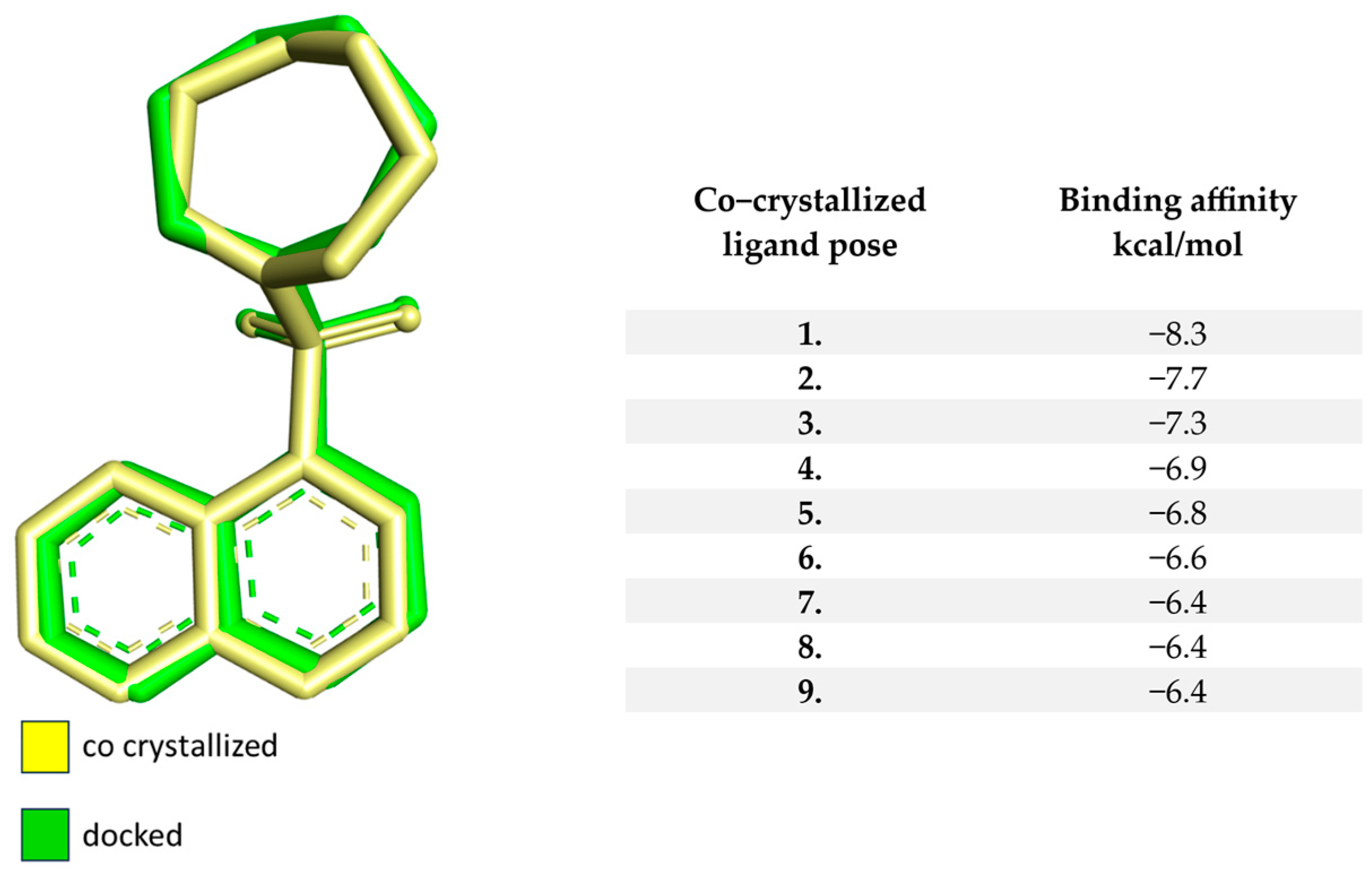
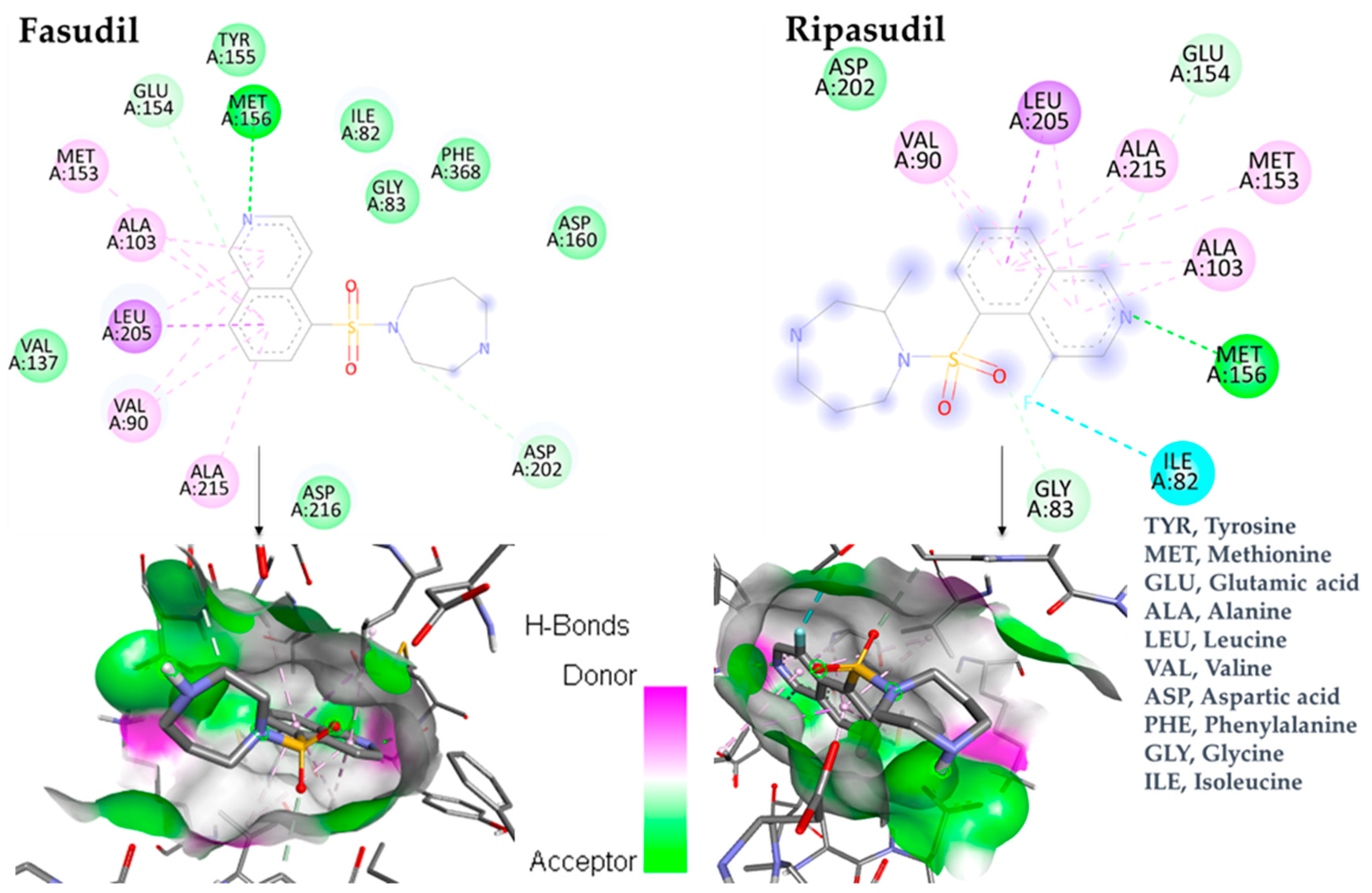


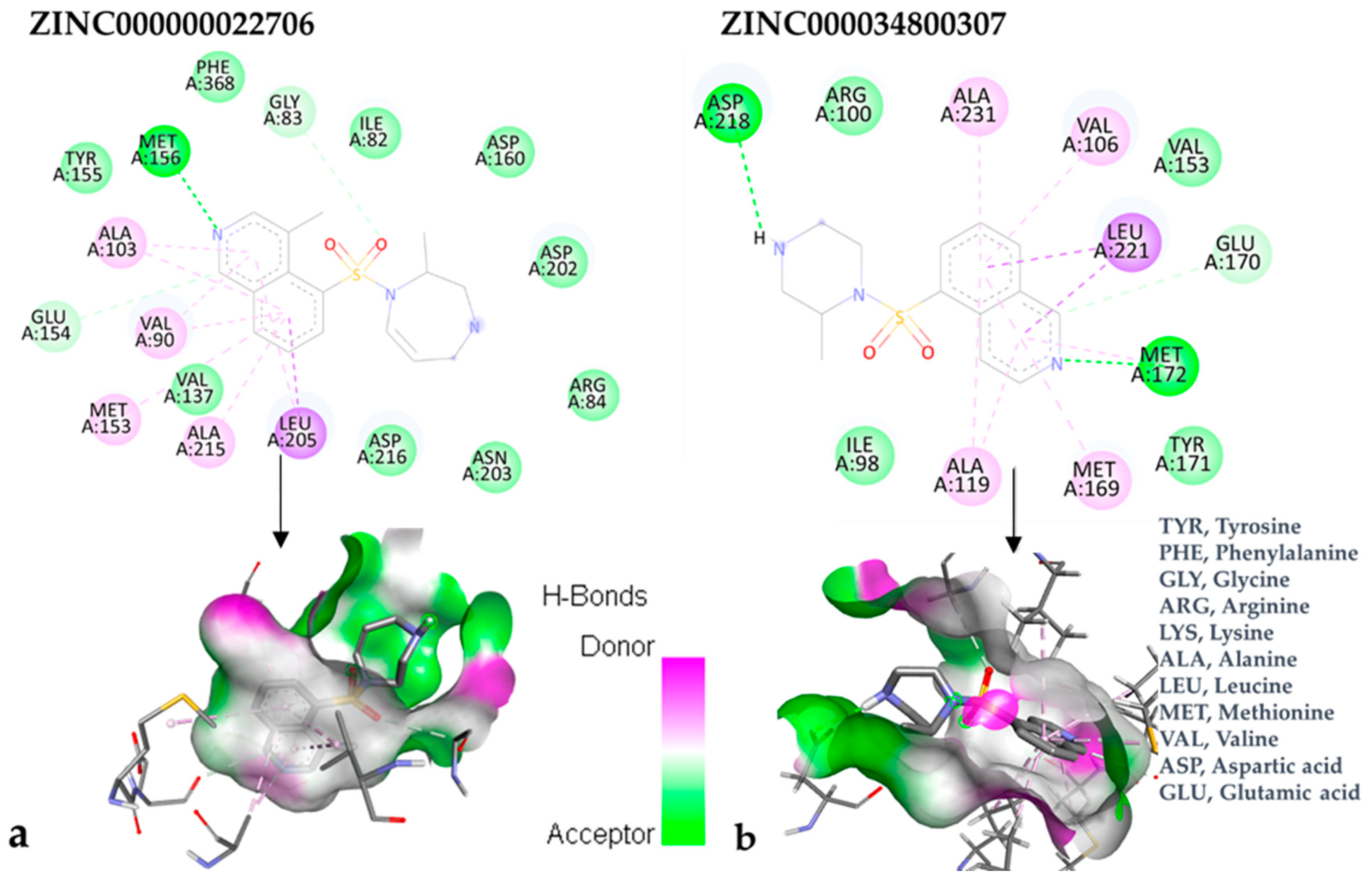

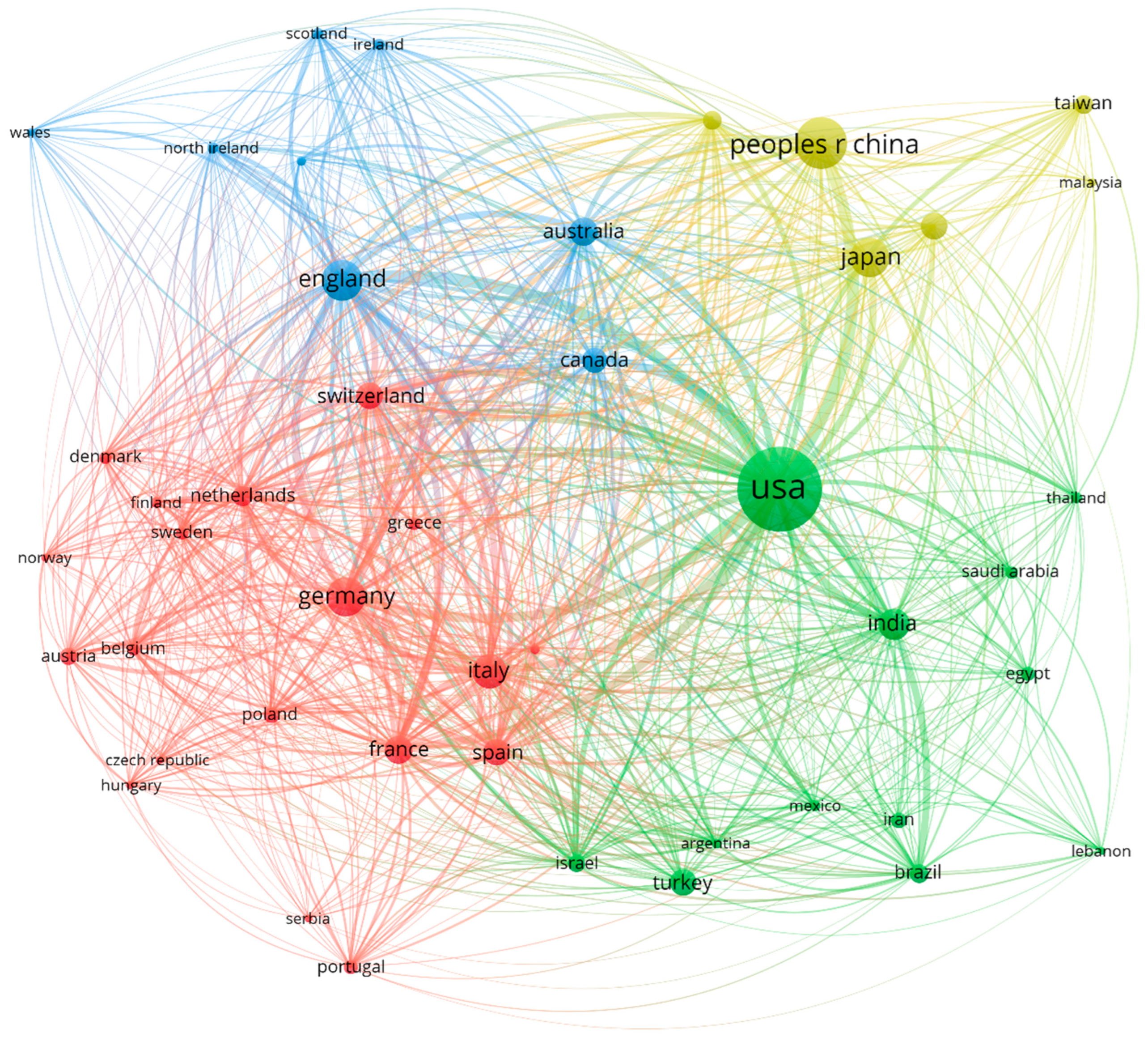
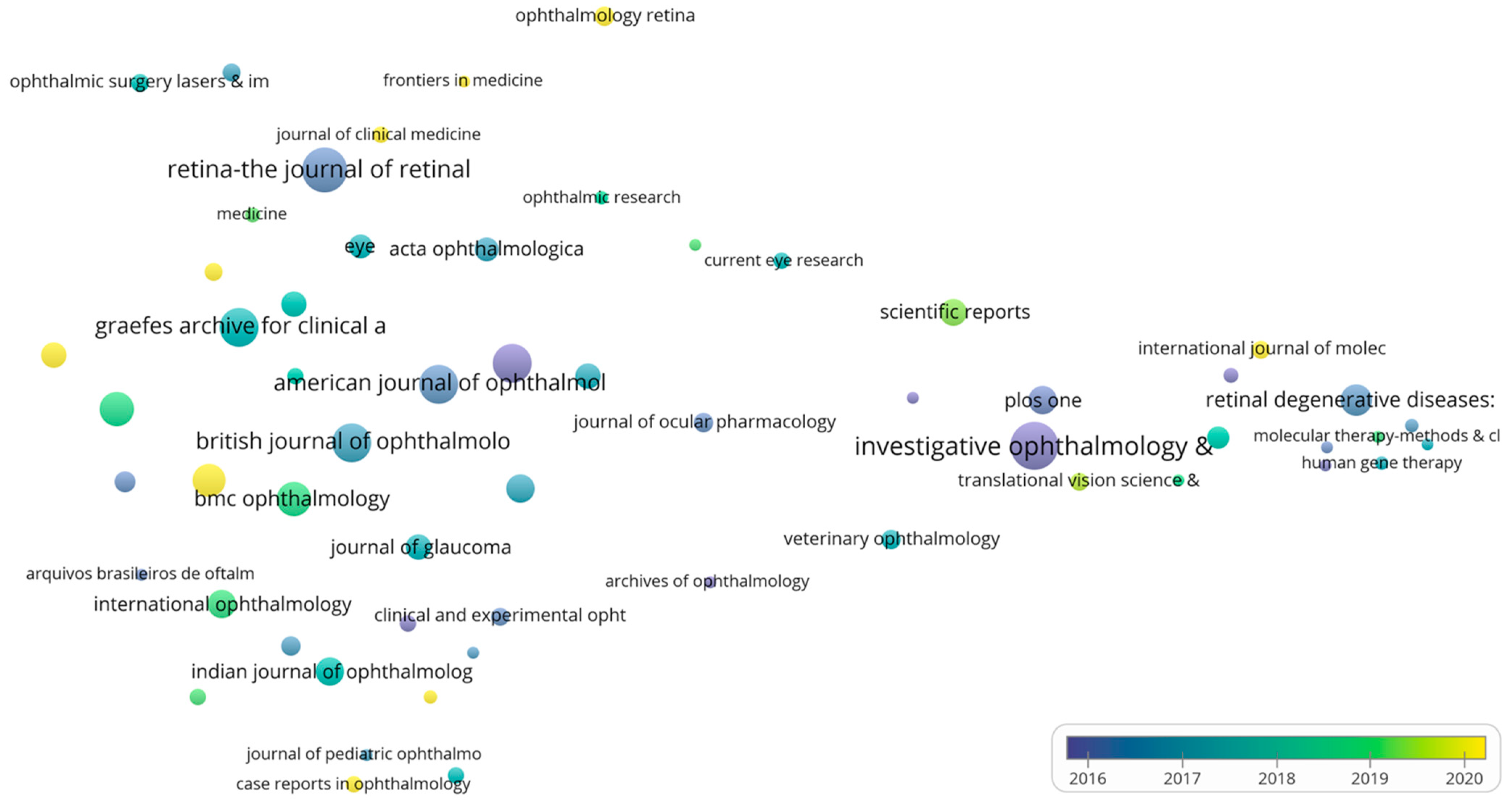
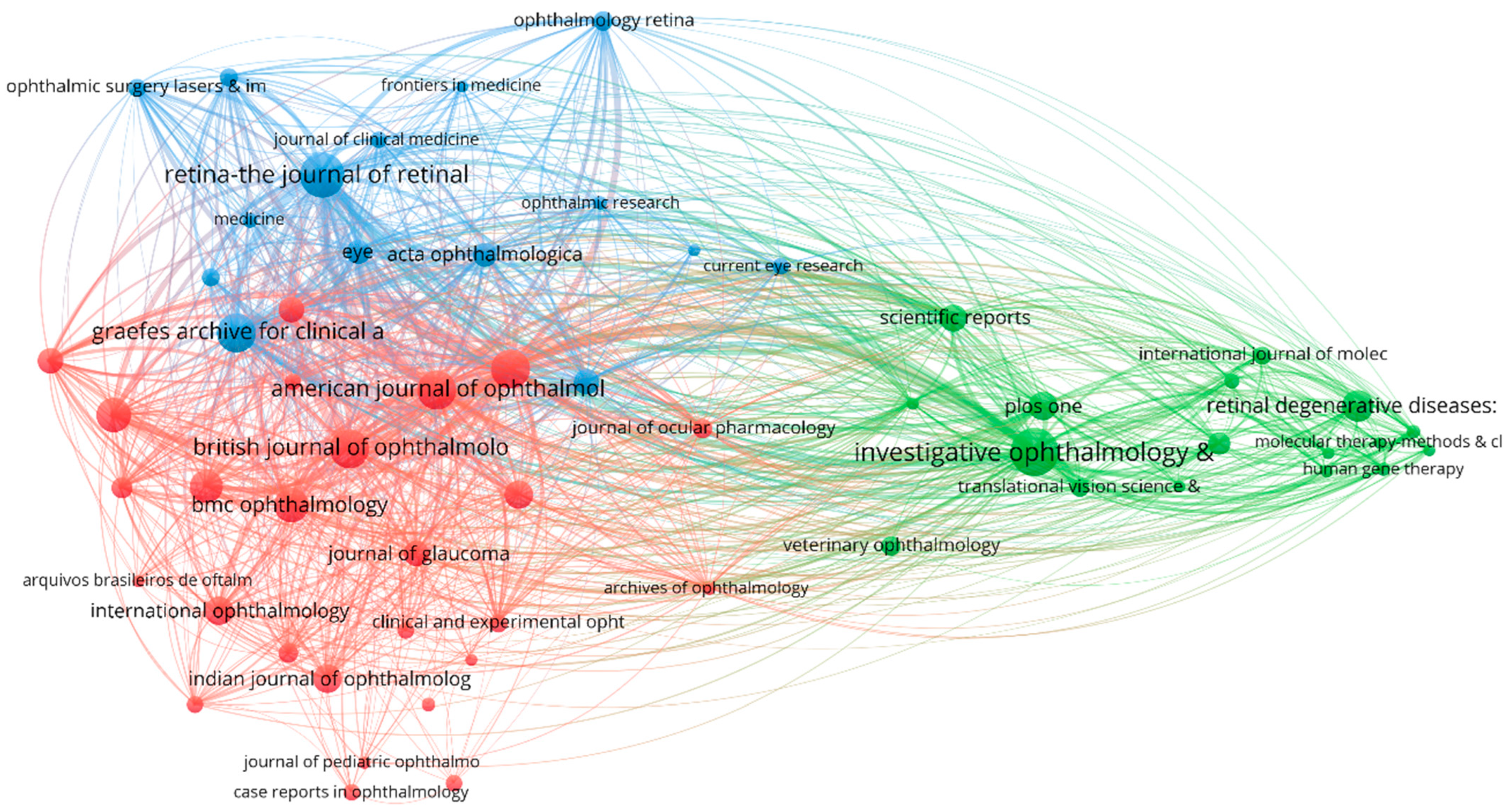


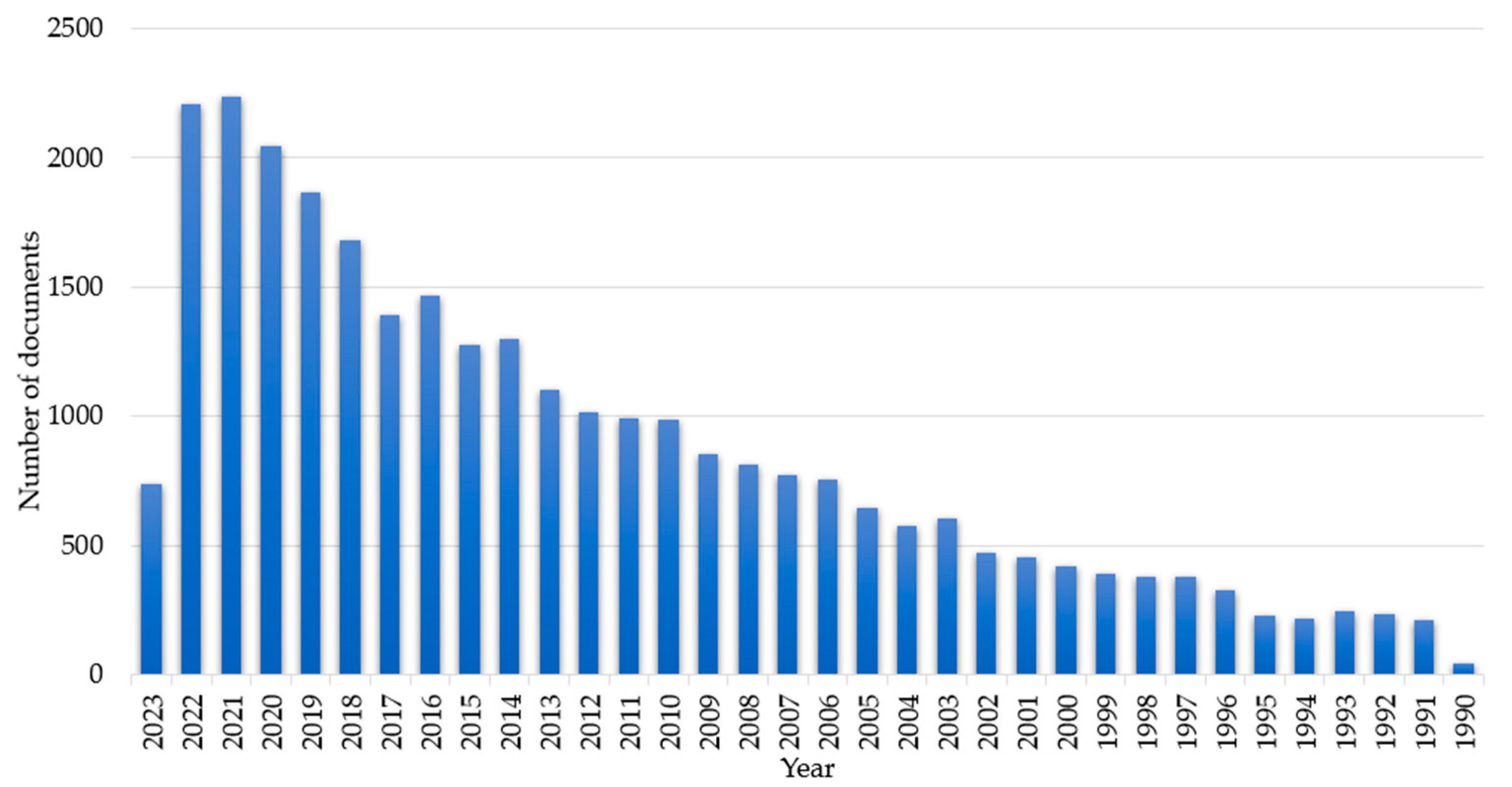
| Compound | Chemical Structure | Binding Affinity (kcal/mol) | Score of Similarity |
|---|---|---|---|
| ZINC000000022706 |  | −9.0 | 0.772 |
| ZINC000193357696 |  | −7.3 | 0.508 |
| ZINC000193358334 | 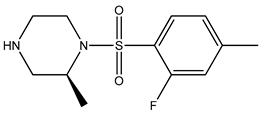 | −7.3 | 0.492 |
| ZINC000034800306 | 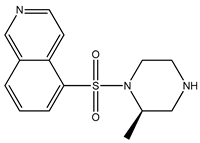 | −7.1 | 0.590 |
| ZINC000034800307 |  | −7.1 | 0.590 |
| Compound | Chemical Structure | Binding Affinity (kcal/mol) | Score of Similarity |
|---|---|---|---|
| ZINC000034800307 |  | −8.8 | 0.590 |
| ZINC000000022706 |  | −8.6 | 0.772 |
| ZINC000054371104 |  | −7.7 | 0.492 |
| ZINC000193357696 | 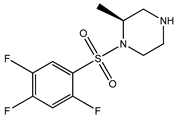 | −7.6 | 0.590 |
| ZINC000534634918 | 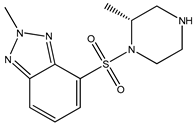 | −7.6 | 0.590 |
| Characteristics | ZINC000000022706 (ROCK1) | ZINC000034800307 (ROCK2) |
|---|---|---|
| Formula | C16H21N3O2S | C14H17N3O2S |
| Molecular weight | 319.42 g/mol | 291.37 g/mol |
| Num. rotatable bonds | 2 | 2 |
| Num. H-bond acceptors | 5 | 5 |
| Num. H-bond donors | 1 | 1 |
| Log P | 2.50 | 2.10 |
| Gastrointestinal absorption | High | High |
| CYP2C19 inhibitor | No | No |
| CYP2C9 inhibitor | No | No |
| CYP2D6 inhibitor | Yes | No |
| CYP3A4 inhibitor | Yes | No |
| Lipinski | Yes | Yes |
| Country | Papers | Citations | Average Citation/Article | Total Link Strength (TLS) |
|---|---|---|---|---|
| United States | 6736 | 179,553 | 26.66 | 4451 |
| China | 2503 | 31,820 | 12.71 | 1151 |
| England | 1555 | 47,090 | 30.28 | 2482 |
| Japan | 1444 | 30,626 | 21.21 | 745 |
| Germany | 1432 | 39,223 | 27.39 | 2088 |
| Italy | 1188 | 25,012 | 21.05 | 1559 |
| India | 973 | 13,759 | 14.14 | 923 |
| France | 750 | 24,467 | 32.62 | 1572 |
| Australia | 739 | 22,583 | 30.56 | 1378 |
| South Korea | 713 | 12,330 | 17.29 | 354 |
| Journals | No. of Papers | No. of Citations | Average No. of Citations per Article | IF | IF without Self-Citations | Publishing Entity |
|---|---|---|---|---|---|---|
| Investigative Ophthalmology & Visual Science | 896 | 24,621 | 27.48 | 4.925 | 4.589 | Assoc Research Vision Ophthalmology Inc., Rockville, MD, USA |
| Retina—The Journal of Retinal and Vitreous Diseases | 799 | 17,913 | 22.42 | 3.975 | 3.617 | Lippincott Williams & Wilkins, Philadelphia, PA, USA |
| Graefe’s Archive for Clinical and Experimental Ophthalmology | 615 | 8208 | 13.35 | 3.535 | 3.372 | Springer, Berlin/Heidelberg, Germany |
| British Journal of Ophthalmology | 610 | 13,254 | 21.73 | 5.907 | 5.565 | BMJ Publishing Group, London, UK |
| American Journal of Ophthalmology | 601 | 19,127 | 31.83 | 5.488 | 5.128 | Elsevier Science Inc., Amsterdam, The Netherlands |
| Ophthalmology | 594 | 39,344 | 66.24 | 14.277 | 13.741 | Elsevier Science Inc., Amsterdam, The Netherlands |
| European Journal of Ophthalmology | 466 | 3257 | 6.99 | 1.922 | 1.743 | Sage Publications Ltd., New York, NY, USA |
| BMC Ophthalmology | 452 | 3712 | 8.21 | 2.086 | 1.992 | BMC, London, UK |
| Ophthalmology and Therapy | 415 | 1594 | 3.84 | 4.927 | 4.759 | Springer Int Publ Ag, Cham, Switzerland |
| PLoS ONE | 322 | 6701 | 20.81 | 3.752 | 3.608 | Public Library Science, San Francisco, CA, USA |
| Authors’ Name | Latest Affiliation | Nation | No. | No. of Citations | Average Citations per Document |
|---|---|---|---|---|---|
| Bandello, F. | Vita-Salute San Raffaele University | Italy | 112 | 2034 | 18.16 |
| Hauswirth, W.W. | University of Florida | United States | 92 | 4404 | 47.87 |
| Maclaren, R.E. | University of Oxford | England | 91 | 2916 | 32.04 |
| Liu, Y. | - | - | 85 | 1043 | 12.27 |
| Zhao, M.W. | - | - | 83 | 613 | 7.39 |
| Chhablani, J. | University of Pittsburgh | United States | 81 | 1172 | 14.47 |
| Sahel, J.A. | National Institute of Health and Medical Research (Inserm) | France | 76 | 3819 | 50.25 |
| Shields, C.L. | Jefferson University | United States | 75 | 2441 | 32.55 |
| Freund, K.B. | Vitreous Retina Macula Consultants of New York | United States | 73 | 3476 | 47.62 |
| Holz, F.G. | University of Bonn | Germany | 73 | 4809 | 65.88 |
| Main Author (Year) | Title of the Paper | Scientific Periodical | IF | C | Ref. |
|---|---|---|---|---|---|
| Sawcer, S. (2011) | Genetic risk and a primary role for cell-mediated immune mechanisms in multiple sclerosis | Nature | 69.504 | 1942 | [31] |
| Heier, J.S. (2012) | Intravitreal Aflibercept (VEGF Trap-Eye) in Wet Age-related Macular Degeneration | Ophthalmology | 14.277 | 1562 | [32] |
| Martin, D.F. (2012) | Ranibizumab and Bevacizumab for Treatment of Neovascular Age-Related Macular Degeneration | Ophthalmology | 14.277 | 1315 | [33] |
| Okita, K. (2011) | A more efficient method to generate integration-free human iPS cells | Nature Methods | 47.99 | 1298 | [34] |
| Lim, L.S. (2012) | Age-related macular degeneration | Lancet | 202.731 | 1216 | [35] |
| Mintz-Hittner (2011) | Efficacy of Intravitreal Bevacizumab for Stage 3+Retinopathy of Prematurity. | New England Journal of Medicine | 176.082 | 909 | [36] |
| Quigley, H.A. (2011) | Glaucoma | Lancet | 202.731 | 848 | [37] |
| Mandai, M. (2017) | Autologous Induced Stem-Cell-Derived Retinal Cells for Macular Degeneration | New England Journal of Medicine | 176.082 | 833 | [38] |
| Tang, J. (2011) | Inflammation in diabetic retinopathy | Progress In Retinal and Eye Research | 19.704 | 763 | [39] |
| Rofagha, S. (2013) | Seven-Year Outcomes in Ranibizumab-Treated Patients in ANCHOR, MARINA, and HORIZON | Ophthalmology | 14.277 | 701 | [40] |
| Affiliations | Record Count | % of 19,233 |
|---|---|---|
| University of California System | 885 | 4.60 |
| University of London | 812 | 4.22 |
| University College London | 749 | 3.89 |
| Harvard University | 608 | 3.16 |
| Moorfields Eye Hospital NHS Foundation Trust | 553 | 2.88 |
| Johns Hopkins University | 521 | 2.71 |
| Harvard Medical School | 515 | 2.68 |
| Udice French Research Universities | 456 | 2.37 |
| University of Pennsylvania | 389 | 2.02 |
| Johns Hopkins Medicine | 381 | 1.98 |
Disclaimer/Publisher’s Note: The statements, opinions and data contained in all publications are solely those of the individual author(s) and contributor(s) and not of MDPI and/or the editor(s). MDPI and/or the editor(s) disclaim responsibility for any injury to people or property resulting from any ideas, methods, instructions or products referred to in the content. |
© 2023 by the authors. Licensee MDPI, Basel, Switzerland. This article is an open access article distributed under the terms and conditions of the Creative Commons Attribution (CC BY) license (https://creativecommons.org/licenses/by/4.0/).
Share and Cite
Bodea, F.; Bungau, S.G.; Negru, A.P.; Radu, A.; Tarce, A.G.; Tit, D.M.; Bungau, A.F.; Bustea, C.; Behl, T.; Radu, A.-F. Exploring New Therapeutic Avenues for Ophthalmic Disorders: Glaucoma-Related Molecular Docking Evaluation and Bibliometric Analysis for Improved Management of Ocular Diseases. Bioengineering 2023, 10, 983. https://doi.org/10.3390/bioengineering10080983
Bodea F, Bungau SG, Negru AP, Radu A, Tarce AG, Tit DM, Bungau AF, Bustea C, Behl T, Radu A-F. Exploring New Therapeutic Avenues for Ophthalmic Disorders: Glaucoma-Related Molecular Docking Evaluation and Bibliometric Analysis for Improved Management of Ocular Diseases. Bioengineering. 2023; 10(8):983. https://doi.org/10.3390/bioengineering10080983
Chicago/Turabian StyleBodea, Flaviu, Simona Gabriela Bungau, Andrei Paul Negru, Ada Radu, Alexandra Georgiana Tarce, Delia Mirela Tit, Alexa Florina Bungau, Cristian Bustea, Tapan Behl, and Andrei-Flavius Radu. 2023. "Exploring New Therapeutic Avenues for Ophthalmic Disorders: Glaucoma-Related Molecular Docking Evaluation and Bibliometric Analysis for Improved Management of Ocular Diseases" Bioengineering 10, no. 8: 983. https://doi.org/10.3390/bioengineering10080983
APA StyleBodea, F., Bungau, S. G., Negru, A. P., Radu, A., Tarce, A. G., Tit, D. M., Bungau, A. F., Bustea, C., Behl, T., & Radu, A.-F. (2023). Exploring New Therapeutic Avenues for Ophthalmic Disorders: Glaucoma-Related Molecular Docking Evaluation and Bibliometric Analysis for Improved Management of Ocular Diseases. Bioengineering, 10(8), 983. https://doi.org/10.3390/bioengineering10080983









